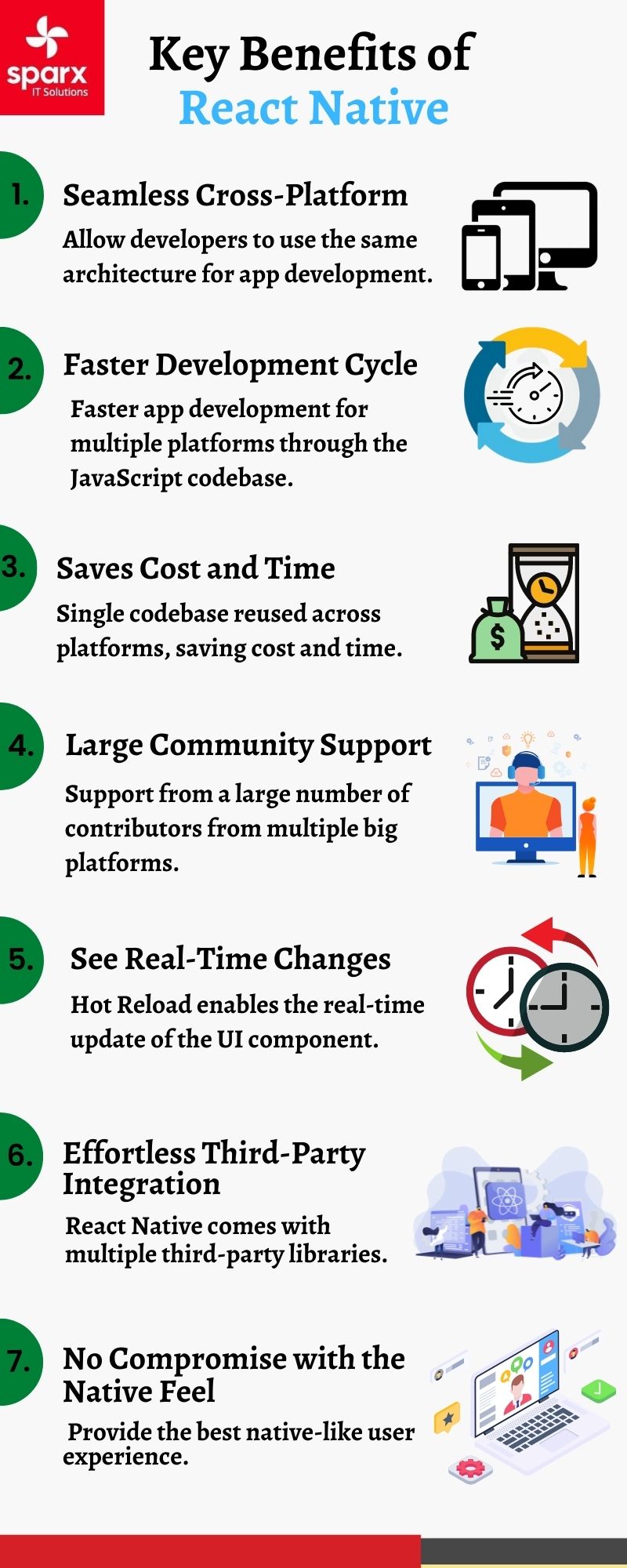Initially, app developers have to use the technology based on the specific app platform, like iOS or Android, for developing two different native applications.
In mobile platforms, user division is unbalanced, making it difficult for app developers to build compatible apps on multiple platforms. At the same time, building apps for different platforms can increase the development cost.
However, things changed after the advent of cross-platform frameworks like React Native. It made it possible to write code once and develop mobile apps that can be executed on various mobile operating systems.
This blog will lay out key features and benefits of React Native and how it is the best choice for creating hybrid apps.
What is React Native?
React Native is an open-source, JavaScript-based framework used for developing apps on multiple platforms like iOS, Android, and Windows. It enables the code reuse capabilities across platforms while letting you create truly native apps without compromising your users’ experiences.
Using the concept of Bridge, React Native enables the asynchronous transmission between the JavaScript and Native elements of the mobile OS. Due to this, JavaScript and Native elements are able to communicate irrespective of being different technologies.
Key Features of React Native
Native and Core Components
In Android, you use Kotlin or Java, whereas, in iOS, you use Swift or Objective-C to develop an app. However, with React Native, you can invoke these views using JavaScript. React Native has various core components that you get to work with, from form controls to activity indicators. It also comes with several Native Components you can use while building your app.
Rendered with Native Code
React Native app development services maintain the native-like experience of apps across platforms with a single shared codebase. The code is written in JavaScript and rendered to the native UI of the platform, meaning your users will get to experience the same native platform interface as other apps.
Custom Components
Props (short for “properties”) enable you to customize React components. Apart from Core Components, React Native allows you to nest these components to render other components, allowing you to fabricate new ones.
Platform Specific Folder
React Native enables you to reuse code while developing a cross-platform app. However, you may need to code on specific platforms in certain scenarios. In that case, React Native provides platform modules and platform-specific file extensions, through which you can code as per the particular platform.
Live Reloading
React Native provides the best experience to the developers by supporting Live Reloading, through which you can introduce new features while keeping the app in running condition. With this feature, you do not lose any of your states and showcase the changes made simultaneously.
Flux and Redux Architecture
Flux architecture is used to introduce the unidirectional data flow that enhances the React performance by preventing the complexity of the application. Redux is the predictable state container for JavaScript apps that provides a manner to manage the store and data flow.
Block-Based UI Components
React Native lets you write the UI Components like the layout, spacing, and typography by encapsulating these styles with a block. These components are helpful to promote reusability.
Performance-Oriented Approach
React Native uses a JavaScript transpiler, Babel, to transpile React syntax into the code that can be executed in a JavaScript environment. With this, developers can create new features in JavaScript and run smoothly on Android and iOS platforms.
Moreover, React Native displays 60 frames per second, providing a smooth and ultimate user experience.
Modular and Intuitive Architecture Approach
React Native follows a modular approach to writing code that makes managing the application interface for Android and iOS platforms easier.
Best NPM Libraries Supported
In React Native, you are limited to only Core Components, and it supports NPM (Node Package Manager) that you can install from the npm registry. With the help of that library, you can integrate that particular functionality into your app.
Benefits of React Native

Seamless Cross-Platform
React Native provides the ability to easily use the same architecture for hybrid mobile app development via the declarative UI paradigm approach and JavaScript programming language.
Also, it allows developers to share roles across platforms or review each other’s code, which provides a whole new pattern of app development for existing native developers.
For instance, an iOS app developer can take the responsibilities of the Android developer or vice versa.
Faster App Development
React Native allows invoking views for iOS and Android through JavaScript codebase using React components. React Native creates the platform-specific versions of components, enabling single code to be reused across platforms.
React Native technology allows a single team to manage two platforms simultaneously. This can make the development process to be more efficient and faster. Also, it makes the testing and maintenance much easier to manage.
Saves Cost and Time
React Native makes the code reuse property feasible, which means a single JavaScript codebase provides app solutions for multiple mobile platforms.
This enabled developers to develop and test mobile apps for iOS and Android, which means the development process will be faster and cost reduced.
Moreover, React Native is free, easy to learn, and easily accessible. Thus, it is an excellent platform for Hybrid app development services.
Large Community Support
React Native was founded in 2015 by Facebook (now Meta) and the community. React Native has many contributors from multiple big platforms, such as Github with 2k contributors, Microsoft with 7k, 5k on Google, Intel with 2k, 3k on Red Hat, and so on.
A large community is necessary to learn any new feature or resolve queries during app development. React Native members frequently provide updates with new features and speak at various conferences to offer insights on new versions or patches.
See Real-Time Changes
React Native enables quick iteration with the help of JavaScript; also, the changes you make are visible to you immediately. Thus, you don’t have to wait like the native app development to finish making modifications.
A feature like Live Reload enables the real-time update of the UI component. In React Native, you can see the changes reloading in the front-end application as the back-end coding occurs.
Therefore, developers can effortlessly point out the changes needed in the code and implement them immediately.
Effortless Third-Party Integration
You can not only create React Native apps for multiple mobile OSs, but you can also effortlessly synchronize various third-party services like Cameras, access to the gallery, GPS, etc.
React Native comes with multiple third-party libraries that can be plugged in to access that service. Also, one gets access to a lot of data and modules via the third-party plugin in React Native that has an open-source, fully functional small database library.
It immensely reduces the workload of the React Native app development company and the programmer’s effort to write specific code to integrate external applications.
No Compromise with the Native Feel
In React Native, the app utilizes the same native platform APIs like other apps as react-primitives render to native platform UI. Thus, React Native will provide you full benefits of native apps and rectify the limitations of hybrid mobile app development.
React Native provides core native components like View, Text, and Image. These core components map straight to the native UI building blocks of the platform that give the best native-like user experience.
Top Brands Using React Native
React Native is used to developing applications like Facebook analytics, Facebook ads, and the Facebook app. These cross-platform apps meet the UI standard of different platforms flawlessly.
Instagram is one of the widely used social networking sites owned by Facebook (now Meta) as of 2012, has switched to React Native. It uses features like Live Reload to deliver features faster.
Skype
Skype is a broadly used video chat software that also uses React Native. Microsoft is one of the top contributors of React Native and uses this framework to offer a similar feature of the Skype desktop version on mobile apps.
Pinterest is a social network people use for posting and pinning ideas on multiple topics. The main objective of Pinterest to use React Native is to reduce the code and develop features for iOS and Android quickly.
Walmart
Walmart found that the hybrid web view implementations lack the native feels of the app. Thus, they decided to use React Native for app development as their current web codebase uses React and Redux.
Bloomberg
Bloomberg delivers business and financial insights worldwide. Their consumer mobile app uses React Native to offer its services like personalized content, videos, and live feeds for iOS and Android.
Conclusion
React Native framework has a great set of features that present a new means to Hybrid app development companies by overcoming the challenges that hybrid apps might encounter.
Many big industry names use React Native to deliver unmatched UI/UX, leverage iOS and Android user base, and drive growth. Thus, we can say that the hybrid apps will be more based on React Native in the future.
Our proficient React Native app developers can fulfill all your development needs.
You can hire dedicated React Native developers from us to fulfill all your development needs. Our React Native developers fabricate high-performance cross-platform mobile applications.



